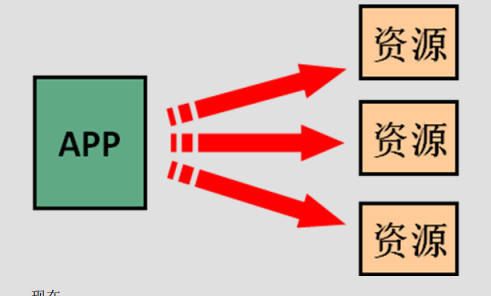Spring框架学习01
写在前面
这学期给自己定的目标有两个,一个是安卓开发一个是SSM。正好近期APP的十天冲刺告一段落,系主任让我们好好放假玩。五一这几天正好适合拿来学习SSM框架。今天先开了个头,学了下Spring框架的基础知识,为什么使用Spring框架等等。
为什么要使用Spring框架?
在我们学习代码的路上,老是听到这样一句话:我们写程序讲究的是一个高内聚低耦合。可这句话是什么意思呢?又有什么用呢?为什么这么做呢?首先,高内聚低耦合的意思就是说,我们要降低程序与程序之间的联系,不会牵一发而动所有。试想,在开发里我改了一个模块,所有的系统都要改,这还了得?所以这种开发规范可以很好的降低我们开发的难度,使得开发更加简单,更加容易分工。那么我们在程序中什么情况下会遇到呢?先看一段经典的java web的JDBC代码:
public class AccountServiceImpl implements IAccountService {
private IAccountDao accountDao = new AccountDaoImpl();
@Override
public void saveAccount() {
accountDao.saveAccount();
}
这是一段经典的java web代码,我们在service层实现service接口,且new了一个dao接口来实现方法。很明显地我们可以看到,这里的程序耦合度十分的高。要是我们的dao接口出了什么问题,service就会崩掉,无法使用。我们肯定要避免这种结果的。那怎么搞呢?我们可以将他new的权限剥夺,让他变成被动,让别人给他。这样他与dao接口的耦合就会很明显的降低了。这其实就是Spring框架的核心思想:IOC(控制反转)。
Spring框架的IOC原理和使用
原理
我们来看一张图,这是典型的结构:

那么我们使用了spring框架后呢?

可以明显地看到耦合度降低了。但有人可能要说了,这不还是有耦合度嘛。需要注意的是我们不可能完全避免耦合,只能做到低耦合。这种方式的耦合度要比new对象的耦合度低的多。
使用
主程序代码:
/**
* 获取spring的Ioc核心容器,并根据id获取对象
*
* ApplicationContext的三个常用实现类
* ClassPathXmlApplicationContext:它可以加载类路径下的配置文件,要求配置文件必须在类路径下.(更常用,指1和2)
* FileSystemApplicationContext:它可以加载磁盘任意路径下的配置文件(必须有访问权限)
* AnnotationConfigApplicationContext:它是用于读取注解创建容器的.
* 核心容器的两个接口引发出的问题:
* ApplicationContext(单例对象适用,多用此接口):它在构建核心容器时创建对象采取的策略是采用立即加载的方式,只要一读取完配置文件马上就创建配置文件中配置的对象.
* BeanFactory(多例对象适用):它在构建核心容器时,创建对象采取的策略是采用延迟加载的方式,也就是说什么时候根据id获取对象,什么时候才创建对象.
* @param args
*/
public static void main(String[] args) {
//1.获取核心容器对象
ApplicationContext ac = new ClassPathXmlApplicationContext("bean.xml");
ApplicationContext ac = new FileSystemXmlApplicationContext("C:\\Users\\10985\\Desktop\\bean.xml");
//2.根据id获取Bean对象
IAccountService as = (IAccountService) ac.getBean("accountService");
IAccountDao adao = ac.getBean("accountDao",IAccountDao.class);
System.out.println(as);
System.out.println(adao);
//as.saveAccount();
//-----------BeanFactory-------
Resource resource = new ClassPathResource("bean.xml");
BeanFactory factory = new XmlBeanFactory(resource);
IAccountService as = (IAccountService) factory.getBean("accountService");
System.out.println(as);
}
bean.xml代码:
<?xml version="1.0" encoding="UTF-8"?>
<beans xmlns="http://www.springframework.org/schema/beans"
xmlns:xsi="http://www.w3.org/2001/XMLSchema-instance"
xsi:schemaLocation="http://www.springframework.org/schema/beans http://www.springframework.org/schema/beans/spring-beans.xsd">
<!-- 把对象的创建交给spring来管理-->
<bean id="accountService" class="com.liuge.service.impl.AccountServiceImpl"></bean>
<bean id="accountDao" class="com.liuge.dao.impl.AccountDaoImpl"></bean>
</beans>
可以看到,使用spring的方式很简单,只需要正确配置好文件即可.
spring中的依赖注入
依赖注入有三种方式,这里我们学习了前两种:使用构造函数提供,使用set方法提供(更常用)
可注入的对象类型有三种:基本数据类型和String,其他bean类型(在配置文件中或者注解配置过的bean), 复杂类型(集合类),详见bean.xml代码
先定义三个类。
public class AccountServiceImpl1 implements IAccountService {
/**
* 如果是经常变化的方式,并不适合用注入的方式
*/
private String name;
private Integer age;
private Date birthday;
public AccountServiceImpl1(String name, Integer age, Date birthday){
this.name = name;
this.age = age;
this.birthday = birthday;
}
@Override
public void saveAccount() {
System.out.println("service中的saveAccount方法执行了..."+name+","+age+","+birthday);
}
}
public class AccountServiceImpl2 implements IAccountService {
/**
* 如果是经常变化的方式,并不适合用注入的方式
*/
private String name;
private Integer age;
private Date birthday;
public void setName(String name) {
this.name = name;
}
public void setAge(Integer age) {
this.age = age;
}
public void setBirthday(Date birthday) {
this.birthday = birthday;
}
@Override
public void saveAccount() {
System.out.println("service中的saveAccount方法执行了..."+name+","+age+","+birthday);
}
}
public class AccountServiceImpl3 implements IAccountService {
private String[] myStrs;
private List<String> myList;
private Set<String> mySet;
private Map<String,String> myMap;
private Properties myProps;
public void setMyStrs(String[] myStrs) {
this.myStrs = myStrs;
}
public void setMyList(List<String> myList) {
this.myList = myList;
}
public void setMySet(Set<String> mySet) {
this.mySet = mySet;
}
public void setMyMap(Map<String, String> myMap) {
this.myMap = myMap;
}
public void setMyProps(Properties myProps) {
this.myProps = myProps;
}
@Override
public void saveAccount() {
System.out.println(Arrays.toString(myStrs));
System.out.println(myList);
System.out.println(mySet);
System.out.println(myMap);
System.out.println(myProps);
}
}
bean.xml:
<!-- 构造函数注入:
使用的标签:constructor-arg
标签出现的配置:bean标签内部
标签中的属性:
type:用于指定要注入的数据的数据类型,该数据类型也是构造函数中某个或某些参数的类型
index:用于指定要注入的数据给构造函数中指定索引位置的参数赋值.索引的位置从0开始.
name:用于指定给构造函数中指定名称的参数赋值(常用)
============以上三个用于指定给构造函数中哪个参数赋值==========
value:用于提供基本类型和string类型的数据
ref:用于指定其他的bean类型.指在spring的Ioc核心容器中出现过的bean对象
优势:
在获取bean对象时,注入数据是必须的操作,否则对象无法创建成功.
弊端:
改变了bean对象的实例化方式,使我们在创建对象时,如果用不到这些数据,也必须使用.
-->
<bean id="accountService" class="com.liuge.service.impl.AccountServiceImpl1">
<constructor-arg name="name" value="泰斯特"></constructor-arg>
<constructor-arg name="age" value="18"></constructor-arg>
<constructor-arg name="birthday" ref="now"></constructor-arg>
</bean>
<!-- 配置一个日期对象-->
<bean id="now" class="java.util.Date"></bean>
<!-- set方法注入 (更常用)
涉及的标签:property标签
出现的位置:bean标签的内部
标签的属性:
name:用于指定注入时所调用的set方法名称
value:用于提供基本类型和string类型的数据
ref:用于指定其他的bean类型.指在spring的Ioc核心容器中出现过的bean对象
优势:
创建对象时没有明确的限制,可以直接使用默认构造函数
弊端:
如果有某个成员必须有值,则获取对象时有可能set方法没有执行.
-->
<bean id="accountService2" class="com.liuge.service.impl.AccountServiceImpl2">
<property name="name" value="test"></property>
<property name="age" value="21"></property>
<property name="birthday" ref="now"></property>
</bean>
<!-- 复杂类型的注入/集合类型的注入
用于给list结构集合注入的标签:
list array set
用于给map结构注入的标签:
map props
结构相同,标签可以互换
-->
<bean id="accountService3" class="com.liuge.service.impl.AccountServiceImpl3">
<property name="myStrs">
<array>
<value>AAA</value>
<value>BBB</value>
<value>CCC</value>
</array>
</property>
<property name="myList">
<list>
<value>AAA</value>
<value>BBB</value>
<value>CCC</value>
</list>
</property>
<property name="mySet">
<set>
<value>AAA</value>
<value>BBB</value>
<value>CCC</value>
</set>
</property>
<property name="myMap">
<map>
<entry key="testA" value="aaa"></entry>
<entry key="testB">
<value>bbb</value>
</entry>
</map>
</property>
<property name="myProps">
<props>
<prop key="testC">ccc</prop>
<prop key="testD">ddd</prop>
</props>
</property>
</bean>
总结
可以看到,spring的使用大量采用了配置的方式.日后的学习一定要好好学会配置.(想起了mybatis也是用的配置的方式).


